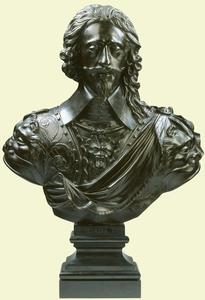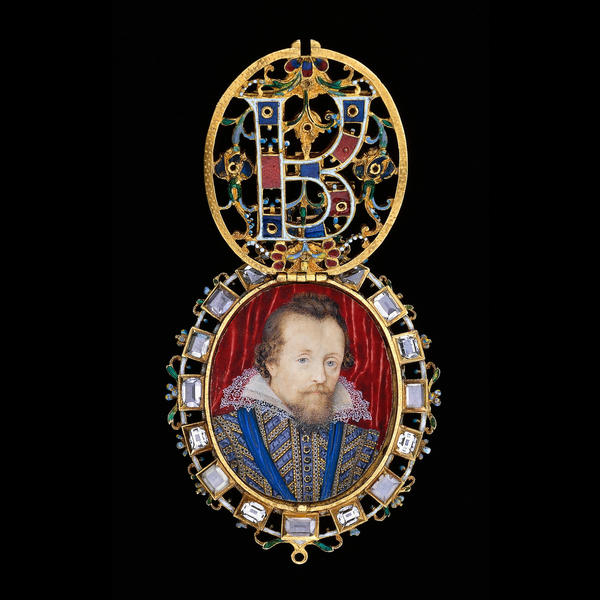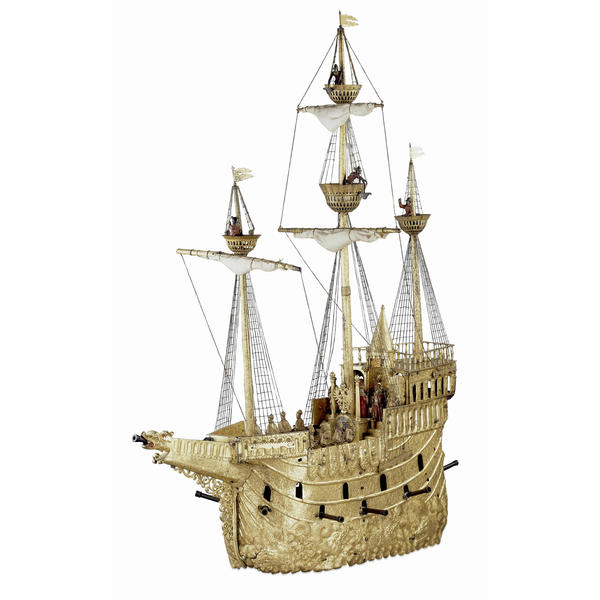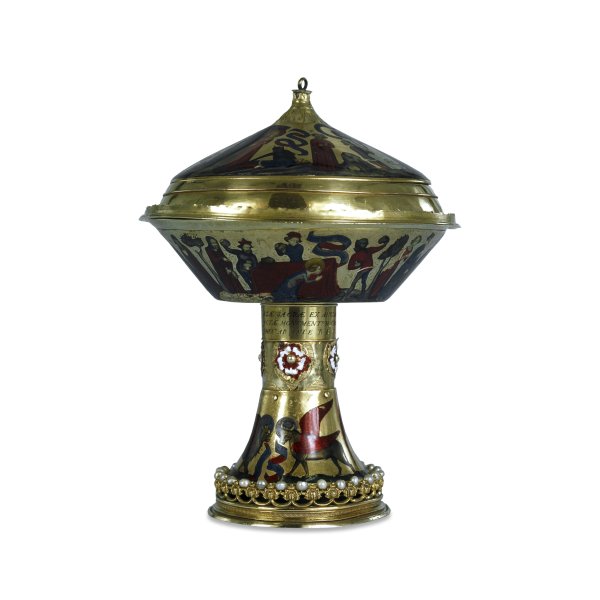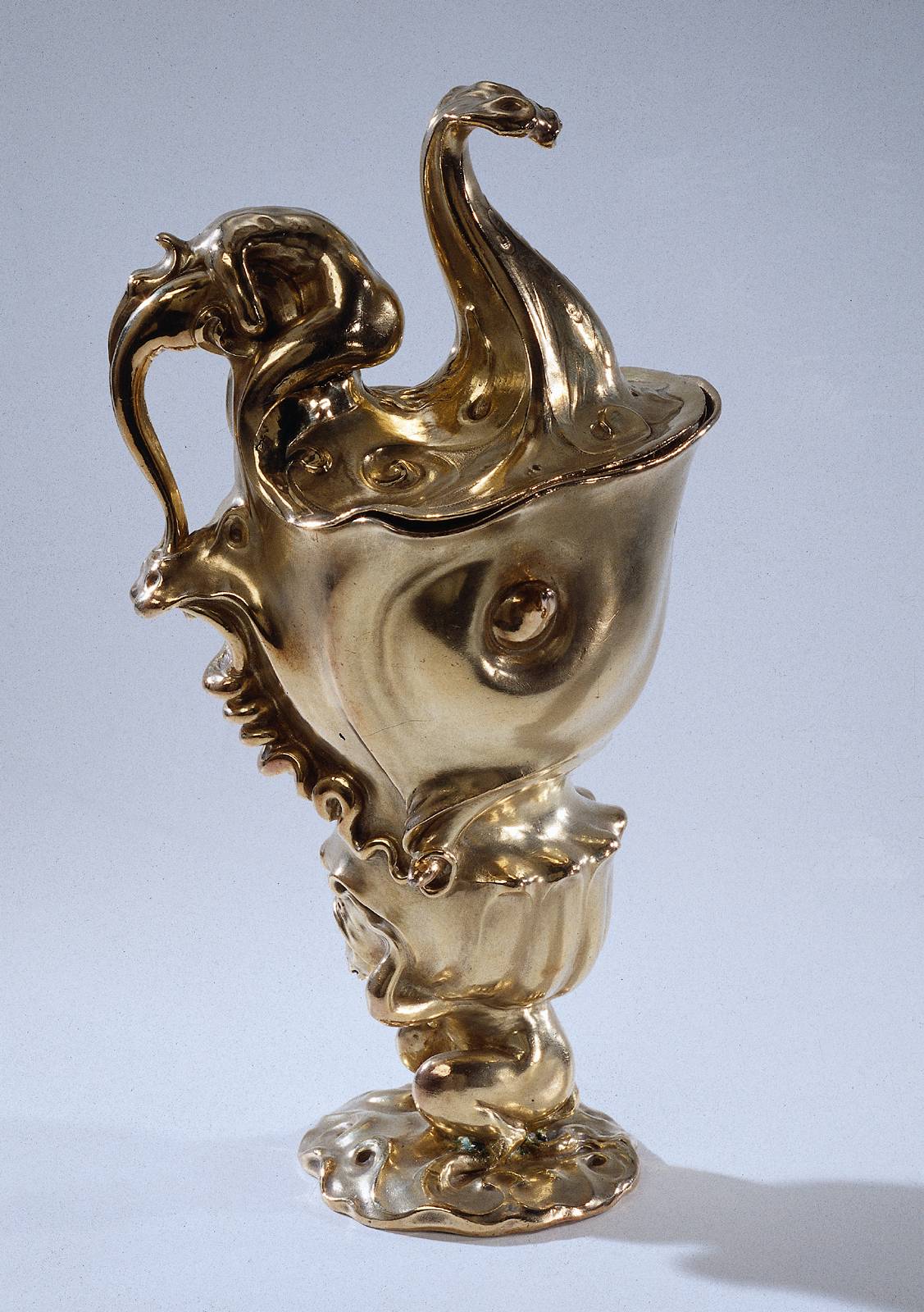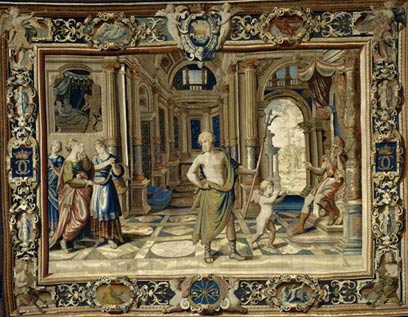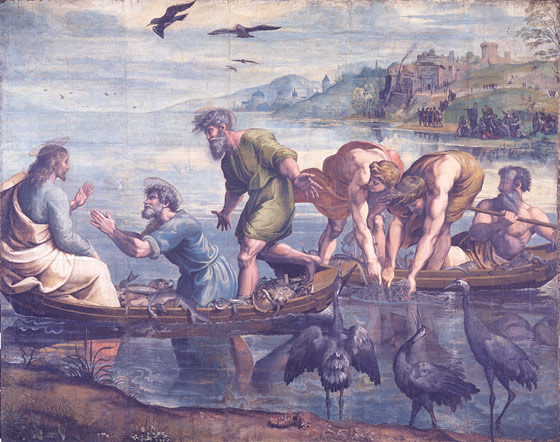Tapestry and Goldsmith’s Work
La Seur busts of Charles I, where are they derived from? Was there a sitting?
One wearing a helmet with a dragon on top, maybe in the guise of St. George or
possibly straight out of a court masque, e.g. as Philogenes the king wore an
extraordinary Romano-British costume.
He was sent to Italy in 1830 to get models, see the letter from Viscount
Wimbledon to Portsmouth regarding inn signs obscuring the statue of Charles I.
He wants sailors to doff their cap to the images. This was done in early times.
This was simply a portrait bust
How you use the king’s portrait was sensitive. Nicholas Hilliard was accused
of putting a portrait of the queen into poison (it turned out the portrait had
been stolen). It is unusual for a portrait to be on public display.
Lyte Jewel (British Museum 1610) contains a miniature of James I by Hilliard.
There was a strong tradition of high quality goldsmith’s work in England. WHy
was so much spent on gold plate across Europe? Financial security of its
material value, hardly anything survives of medieval or Renaissance work as it
was melted down, sometimes by the patron shortly after it had been made, to
raise an army for example. They had no bank accounts. It also had a political
function, such as a gift, to create status (see late 15thC French Charles the
Bold 1470 and Flemish with burning men with gold plate in the background stacked
on shelves). The number of shelves of the buffer was determined by the owner’s
status, for example, a knight might only be allowed one shelf, a marquis two and
a king three.
There is a story of a Duke who invited potential rebels to his palace as they
thought he was short of money but when they saw rooms of gold plate from floor
to ceiling they called off the rebellion as he could clearly afford to bring in
mercenaries to quell it.
1. Burly Nef, 1540, German, British Museum, acoconut carved in low relief and
set in gold.
2. Nef, or galleon, 1585
3. Nautilus shell ship with iridescent mother of pearl ship and gold sails.
4. Seychelles nut turned into a scent fountain, German, gold.
5. Shell, Gilbert Collection, 1590s, German (German items tend to have
survived better).
They would have been found in cabinets of curiosities.
Quartz bowl set in gold.
Two more nefs (French for ship or galleon) set on wheels and used origianlly
for salt but they became too elaborate so they were decorative or used for wine.
By the 18thC they were clockwork and fired their guns and had people climbing
the rigging (V&A). The Duke of Burgundy had such a huge nef that it hid him from
view and had to be moved. It is typical 16thC but also wnet into the 17thC. The
vast majority of gold plate was never used, it was just displayed on shelves.
Royal Gold Cup, 1380, British Museum, French goldsmith’s work and it came
into the Tudor collection when the extension with the Tudor rose was added.
Another collar was added in the 17thC saying it was a present from James I to
the Spanish ambassador and later sold back to Britain. James I inherited items
that dated back to Henry VIII and earlier, for example, a 1530 gold bowl now in
Munich.
By 1626 Charles was in financial difficulties so he sold all the display
plate and looked to replace it with more up to date designs (James commisssioned
old-fashioned Mannerist work with Scottish thistle). Work pioneered in Utrecht
(Rudolph II) and Antwerp an ornate late Mannerist work.
Clasical imagery was introduced and goldsmiths did not know mythology so it
started to be designed by painters such as Durer in Germany and Holbein in
England.
Holbein designed a clock salt. A salt cellar with a built in clock with two
putti on top. Henry VIII had several examples (classical cameos, Renaissance
design) in Goldsmith’s Company in London.
Elizabeth I 1569-70, Vintner’s Company with figures of virtues – a salt
cellar.
How does Charles differ? See photcopy. Adam van Vianen, 1614, organic,
expressionistic, auricular style (ear), cartilaginous feel, in Rijksmuseum
Museum.
In 1613 Paulus van Vianen, the celebrated silversmith, died in Prague. His
death was mourned by many. The Amsterdam silversmith’s guild which had been his
brother’s trademark. Instead of limiting the auricular style to the decoration,
the whole object became one large auricular lobe.
Auricular ornament
Auricular ornament is a lobe-like decoration, like a thick dripping substance
apparently resembling organic shapes. The word auricular refers to the ear, in
particular to the earlobes. In the 17th century auricular ornamentation was also
known as ‘fratsen en snaeckerijen’ – ‘whimsy and drollery’. Auricular ornament
originated in the 16th century as a two-dimensional form in ornamental prints.
It was subsequently employed as a three-dimensional decorative element in frames
of windows and picture and suchlike. The silversmith Paulus van Vianen
(1570-1613) used it frequently; in fact it became his trademark. When Paulus
died, his brother Adam was commissioned to make a commemorative piece. He made a
ewer as one continuous auricular design, thereby raising auricular ornament to a
form in its own right.
Van Vianen also created reliefs in chasing, see copy Paul van Vianen
plaquette, Argus charmed by Mercury, very fashionable, to Charles taste. Late
Mannerist, extended limbs, distorted pose.
The design was raised by the craftsman by hammering so it was very skilled
work and expensive. A cheaper caste version was also available.
Counter-Reformation imagery, Virgin and Child in clouds with St. Apollinaire
(her attributes are pincers used to pull out her teeth) below. Imagine the shock
this would have caused amongst the Protestants. Also produced small medal
portraits of the king and queen.
See copy, the dish could have been made in the 1920s rather than the 1635
showing how revolutionary this style was, It is a dolphin with swirling waves
and the bowl with two sea monsters in the centre. This is a water bowl so the
iconography was appropriate. This auricular style just died out. It is a
complete rejection of the Renaissance style. It is asymmetrical.
See the basin and ewer designed by Rubens. There is an oil sketch of the
birth of Venus in the photocopy, the gold dish is in the British Museum.
The ewer has a judgement of Paris. It is much more traditional then the
auricular.
Goldsmith’s work is a good way of displaying magnificence as is tapestry.
Charles inherited many tapestries going back to the reign of Edward IV and the
1480s. Not all were high cost, in the 1649 inventory some were valued as only a
few shillings, they must have been very worn.
Henry VIII had over 2,000 tapestries – the largest collection ever assembled.
The Story of Abraham tapestries are at Hampton Court and were produced in
Brussels, the unrivalled centre mentioned in the 1649 inventory, 10 tapestries
for '10,000 as they had a lot of gold and silver in them so they were unusually
expensive. They were used in Westminster in a 17thC coronation. Oliver Cromwell
valued and retained them.
Mortlake tapestry workshop in Surrey was set up by Charles I (originally
James) to copy Henry IV in France. Sir Francis Crane paid for the building and
looms in exchange for the fees from the nest four baronets and exclusive maker
of tapestries for the next 21 years. It was founded using Flemish weavers.
See tapestry at V&A, British Gallery,
Vulcan and Venus, 1620-22 made for
Charles. Monogram in border is entwined C’s. Cartouche at top has Prince of
Wales three feathers. Design is 16th century from Henry VIII collection. Made at
Mortlake.
Raphael cartoons were made for tapestry designs. Acquired in 1623 by Charles
for Mortlake to make tapestries but he put them on display and had copies made.
Cartoons valued at '40 each, tapestries made from them '500 each.

